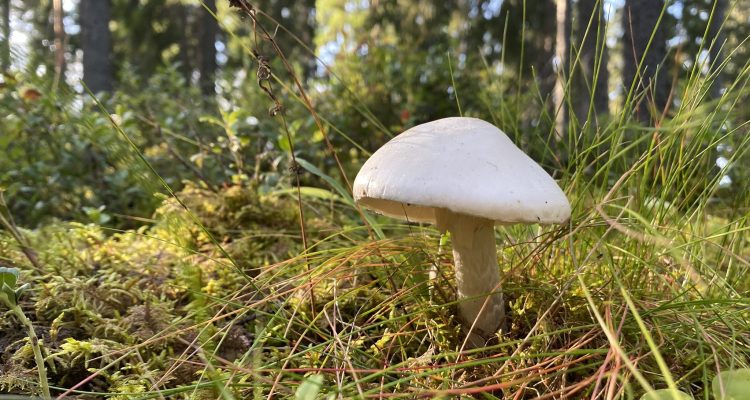Are you familiar with the deadliest mushrooms that grow in Finland? Mushroom foraging is my most beloved pastime in Finland, where the pristine forests offer plenty of delicious fungi. However, this activity comes with a crucial danger: some mushrooms found in Finnish woods can be deadly if consumed. To ensure a safe and enjoyable mushroom foraging experience, it’s essential to be well-informed about the common poisonous mushrooms in the region and how to identify them. In this article, we’ll together explore the top poisonous mushrooms to avoid, and I also provide few tips on identifying mushrooms safely.
The top 5 deadliest mushrooms in Finland
Approximately 50 poisonous mushroom species grow in Finland, five of which can cause deadly poisoning. The top 5 deadliest mushrooms in Finland are: Destroying angel (Amanita virosa), death cap (Amanita phalloides), funeral bell (Galerina marginata), deadly webcap (Cortinarius rubellus), and false morel (Gyromitra esculenta).
The destroying angel, funeral bell, and false morel are common throughout the country. The death cap is quite rare in Finland as it grows only sparingly in the Turku region and more commonly in the Åland Islands. That one I have never seen. The deadly webcap is common in Southern Finland but has been encountered as far north as Finnish Lapland.
Let’s take a closer look at few of them that I have encountered so far. Warning: Do not trust our website for mushroom identification!
Destroying angel (Amanita virosa) – Valkokärpässieni
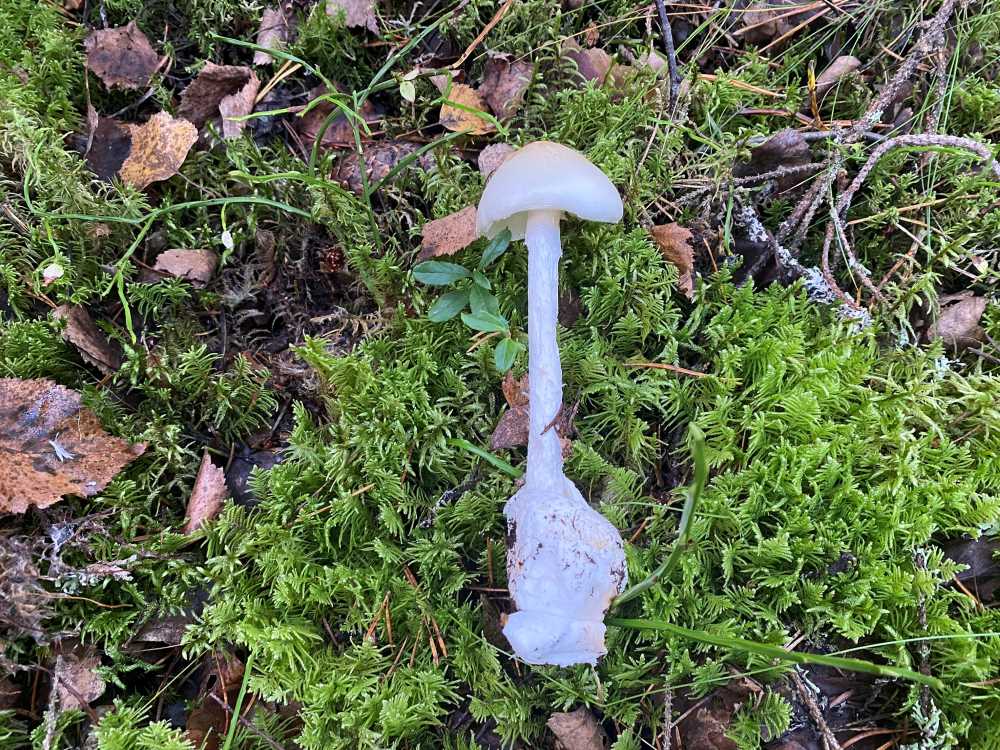
Destroying angel, known as valkokärpässieni in Finnish, is common throughout the country. To me, this mushroom is pretty easy to spot. Apparently, it has caused several fatal mushroom poisonings in Finland in the 21st century and few times the poisoning has led to need for a liver transplant.
The destroying angel is completely white in every part and above all the gills are pure white. Sometimes is shining white as a ghost in green moss bed in the forest. One dead sure way (pun intended) to identify the destroying angel is its tuberous sheath at the base of the leg. However, it is also worth remembering that the sheath easily remains on the ground if you tear the mushroom from the ground carelessly.
Tiny specimens might bear a resemblance to the familiar portobello mushroom for those without expertise, but it’s crucial to note that even a single cap of the destroying angel possesses the potential to kill an adult human. If you are beginner at mushroom foraging, I highly recommend you to stay away from white mushrooms altogether.
Deadly webcap (Cortinarius rubellus) – Suippumyrkkyseitikki
I have read that Cortinarius rubellus, commonly known as the deadly webcap, has been estimated to have caused about 30 serious poisonings in Finland in the last 20 years. The deadly webcap contains highly toxic compound orellanine, which first came to people’s attention in Poland in 1952 when a mass poisoning of 102 people resulted in 11 deaths. The first symptoms of orellanine poisoning usually do not appear until 2 to 14 days after ingestion. They resemble the common flu, and are followed by early stages of kidney failure.
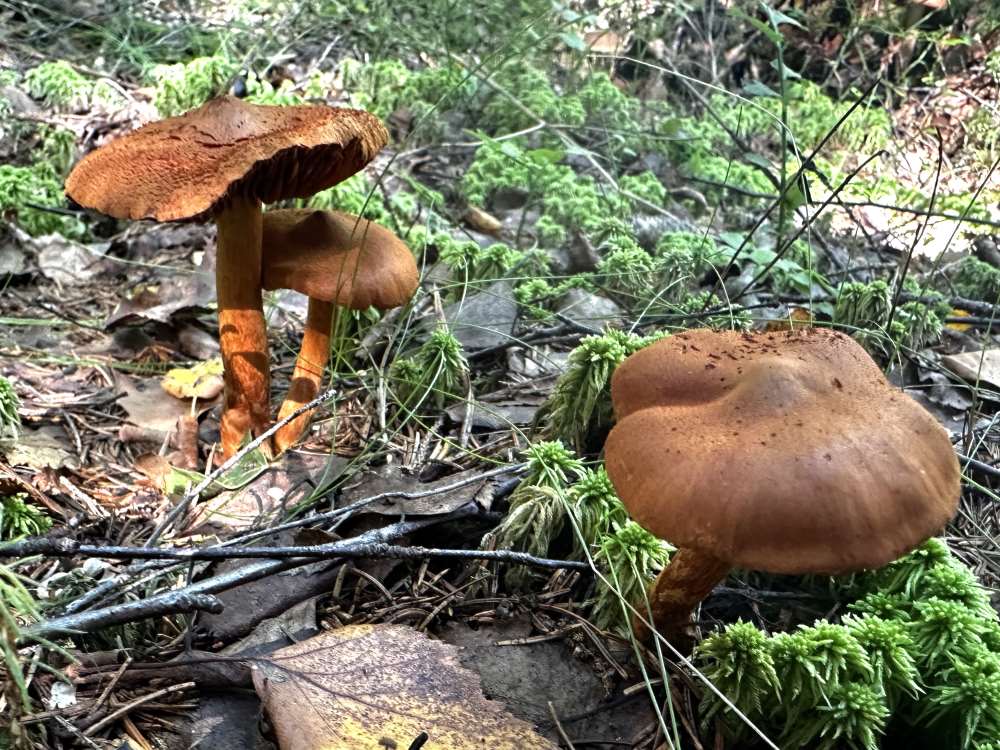
The deadly webcap has a 3–7 cm wide cap colored rusty brown. It often has a steeper and darker colored elevation at the top of the cap, but this varies greatly from specimen to specimen. It grows in pine woods with acidic soil from July to late autumn.
Fool’s webcap (Cortinarius orellanus, lehtomyrkkyseitikki) is common in Central Europe and equally poisonous, but apparently it hasn’t been encountered in Finland. Genus Cortinarius contains actually contains over 2,000 widespread species, hundreds of them growing in Finland. Because of the hazardous toxicity of certain species like Cortinarius rubellus and the challenge in distinguishing between different species within the genus, it is advised that non-experts refrain from consuming mushrooms belonging to this genus.
Funeral bell (Galerina marginata) – Myrkkynääpikkä
Galerina marginata, known colloquially as funeral bell, deadly skullcap, autumn skullcap or deadly galerina, is found particularly in association with decaying wood, leaf litter, or moss. The mushroom contains amatoxins, which can lead to liver and kidney failure. Ingesting even a small amount of the funeral bell can result in severe illness and, in some cases, death if not treated promptly.
Galerina actually means helmet-like. The funeral bell has a small conical to bell-shaped cap. The appearance and growth habit of the mushroom strongly resembles those of the sheathed woodtuft (Kuehneromyces mutabilis, koivunkantosieni), which is considered as valued edible mushroom in Finland. Check out the pictures of the funeral bell here. I won’t post my own pictures as I’m not 100% sure of my identification.
False morel (Gyromitra esculenta) – Korvasieni
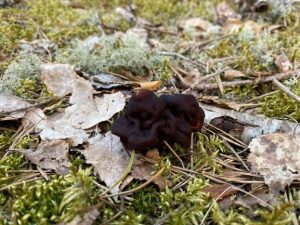
False morels have wrinkled, brain-like caps and they grow in spring, mainly from April to June, but you might encounter them in Lapland still in July. Finland is the only Nordic country where false morel is commonly used as an edible mushroom. While false morels are edible and commonly foraged in Finland, it is absolutely critical to know how to cook them. False morels contain a toxic compound, gyromitrin, which can be fatal if ingested raw. That is why false morels are included in this list. Fresh false morels should be boiled in plenty of water (1 kg of mushrooms, 6 l water) twice for at least 5 minutes each time and rinsed thoroughly after both times in plenty of water. Good ventilation must be ensured when boiling them. Check out also our earlier post: What is the difference between true morels and false morels?
In addition to the top 5 deadliest mushrooms in Finland, there is a recent possible sighting of deadly parasol, Lepiota subincarnata, from Helsinki. Global warming can influence the distribution and prevalence of mushroom species in Finland and elsewhere. As temperatures rise, it can create conditions more favorable for certain mushroom species to thrive in regions where they were previously uncommon or absent.
Other poisonous mushrooms that you should avoid in Finland
In addition to the deadliest mushrooms in Finland, there are several others that can cause milder symptoms of poisoning. Some of them are very common and therefore somewhat dangerous, some can be easily mistaken as other edible mushrooms. I will list here few examples that I have learned to identify and avoid.
Fly Agaric (Amanita muscaria) – Punakärpässieni
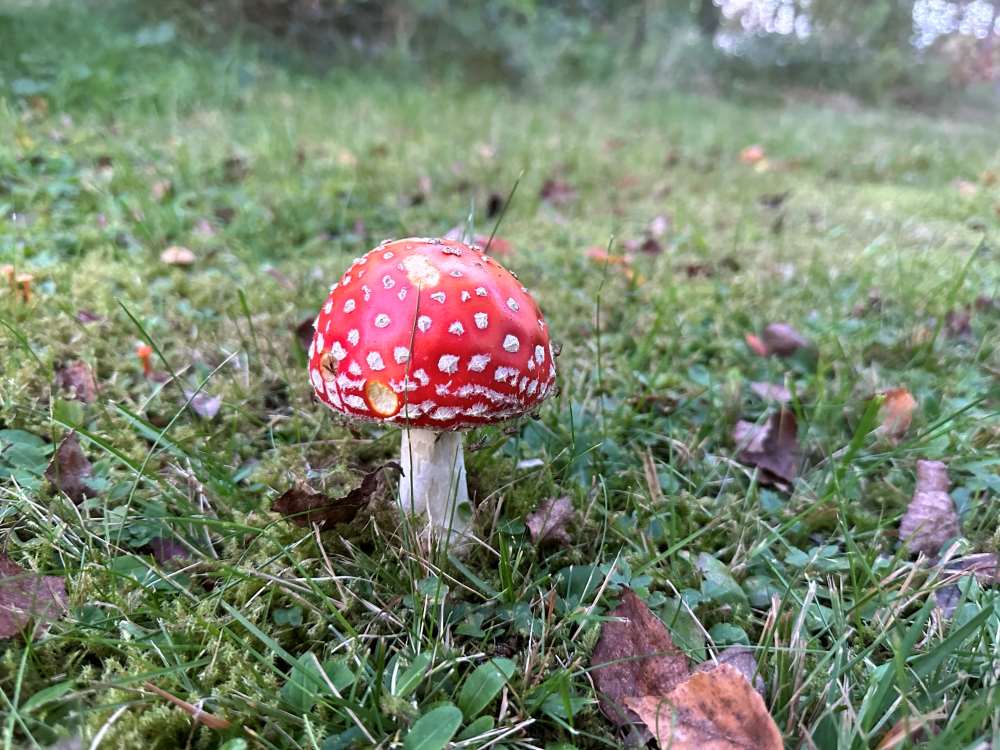
Known for its vibrant red cap adorned with white spots, fly agaric is toxic and can cause hallucinations, confusion, and even death in severe cases. It is very common in Finland, and one danger with this mushroom lies in its white spots. Did you that the main characteristics of the fly agaric might be missing after the rain? Then the red mushroom without its white spots could be mistaken as edible brittlegills. Be especially aware of this when picking red brittlegills. Here’s fly agaric after the rain:

Brown fly agaric (Amanita regalis) – Ruskokärpässieni
The brown fly agaric, also known as the royal fly agaric or the king of Sweden Amanita, may be confused with somewhat edible blusher (Amanita rubescens), highly valued parasol mushroom (Macrolepiota procera), or shaggy parasol (Chlorophyllum olivieri, C. rhacodes). The brown fly agaric is larger than its red cousin and its appearance varies greatly throughout the lifecycle of the fruiting body. It grows very commonly throughout the country in spruce-dominated forests, usually in the company of spruce but also birch. The species is more common in southern Finland than in the north. The toxin contained in the brown fly agaric is the same toxin found in the fly agaric mushroom, but the brown fly agaric causes a more severe poisoning. The main difference between the brown fly agaric and edible blusher is that the ring of the blusher mushroom (Amanita rubescens) is grooved, and its flesh reddens on cut surfaces, unlike the permanently white-fleshed brown fly agaric.
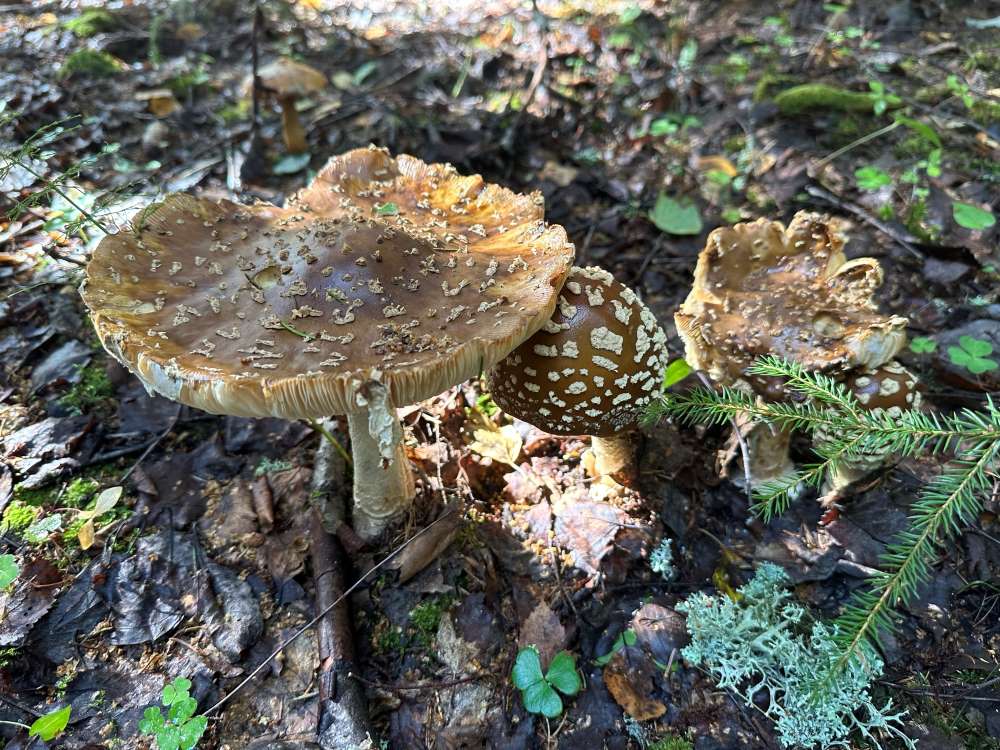
Brown roll-rim (Paxillus involutus) – Pulkkosieni
Paxillus is a genus of mushrooms of which most are known to be poisonous or inedible. Brown roll-rim grows in abundance in Finland from July to October. It has a short and sturdy stem and although it has gills, it is more closely related to the pored boletes than to typical gilled mushrooms. It is usually light brown in color, and has a funnel-shaped cap from 5 to 15 cm wide with a distinctive inrolled rim and decurrent gills. As a special identification, the gills turn darker when touched.
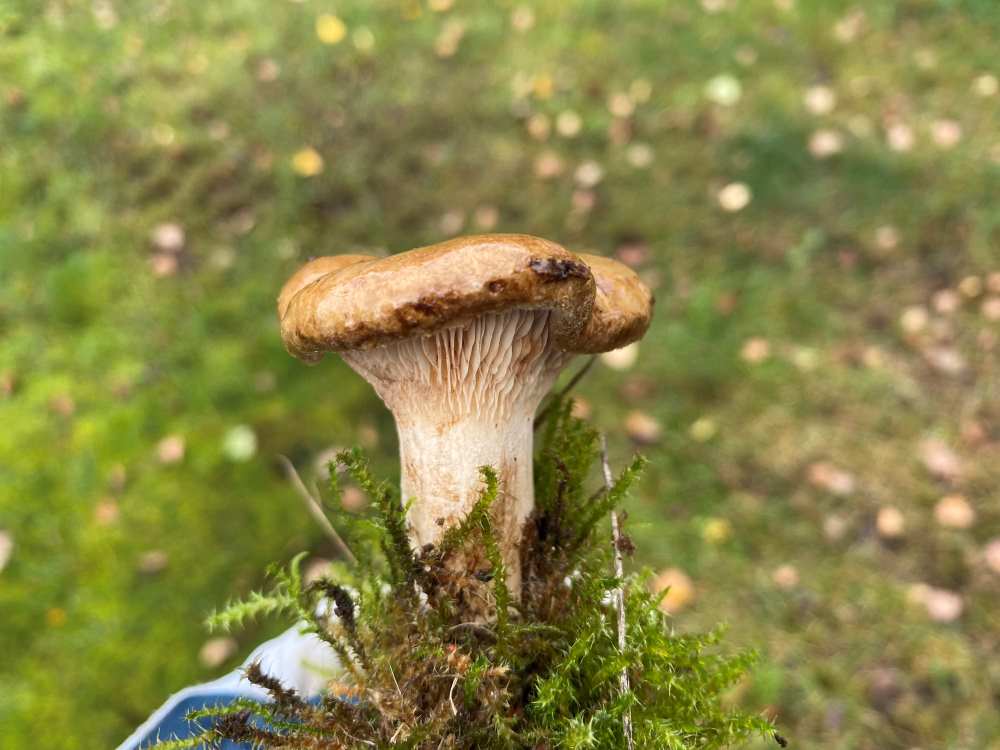
Surprisingly, the brown roll-rim was considered edible mushroom in Finland until the 1970s. The poison of the mushroom accumulates in the body little by little, and the symptoms intensify when the mushroom is constantly used as food. For some, the first time eating the brown roll-rim might even be deadly. As the brown roll-rim is so common and rather innocent looking, accidents happen also with domestic animals. I tend to remove roll-rims from the areas where dogs or kids are playing, just in case.
Jelly baby (Leotia lubrica) – Rustonupikka
This mushroom is mildly poisonous, but its danger lies in the fact that it grows in exactly the same place as funnel chantarelle and it greatly reminds of young funnel chantarelles. In closer inspection you should be able to tell the difference, because jelly baby’s cap and stem are the same color and it feels jelly-like.
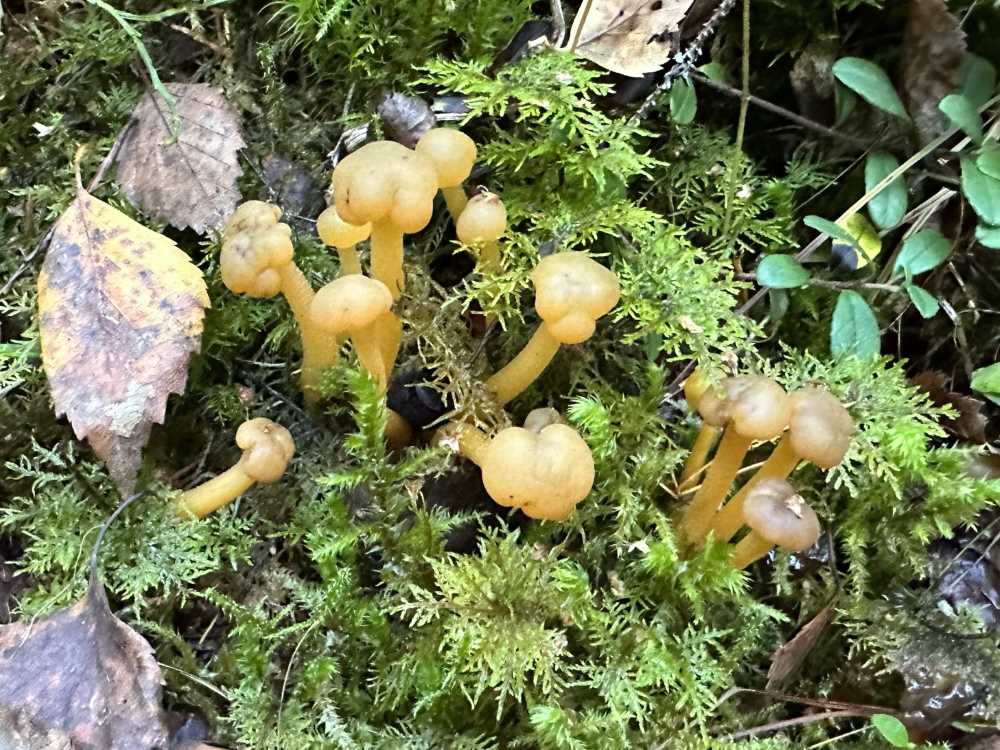
How to avoid the deadliest mushrooms and safely identify them in Finland
- Do not trust Google Lens: Don’t use any apps to identify mushrooms for you. For real. I’ve tried Google Lens and several mushroom apps, and they are often way off. NatureGate lists Finnish mushrooms and their characteristics quite nicely, but there is less content in English than in Finnish.
- Examine key characteristics: When identifying mushrooms, pay close attention to key features such as cap shape, color, gill structure, and stem characteristics. Take note of the mushroom’s habitat as well.
- Start with easy ones: Beginners should stick to easily recognizable edible mushrooms like chanterelles and boletes. As you gain experience, you can expand your foraging repertoire.
- Use all your senses: Don’t rely solely on visual cues. Touch and smell can also provide crucial information. This is why apps cannot safely identify mushrooms.
- Double-check with experts: When in doubt, consult experienced foragers or mycologists for assistance in identifying mushrooms. It’s better to be safe than sorry.
Mushroom foraging in Finland can be a rewarding and satisfying experience, but it’s essential to carefully identify what you forage and be aware of the potentially poisonous mushrooms lurking in the woods. Remember, when in doubt, leave it out of your basket, and always prioritize safety when foraging for these delightful treasures of the forest. Safe foraging!

